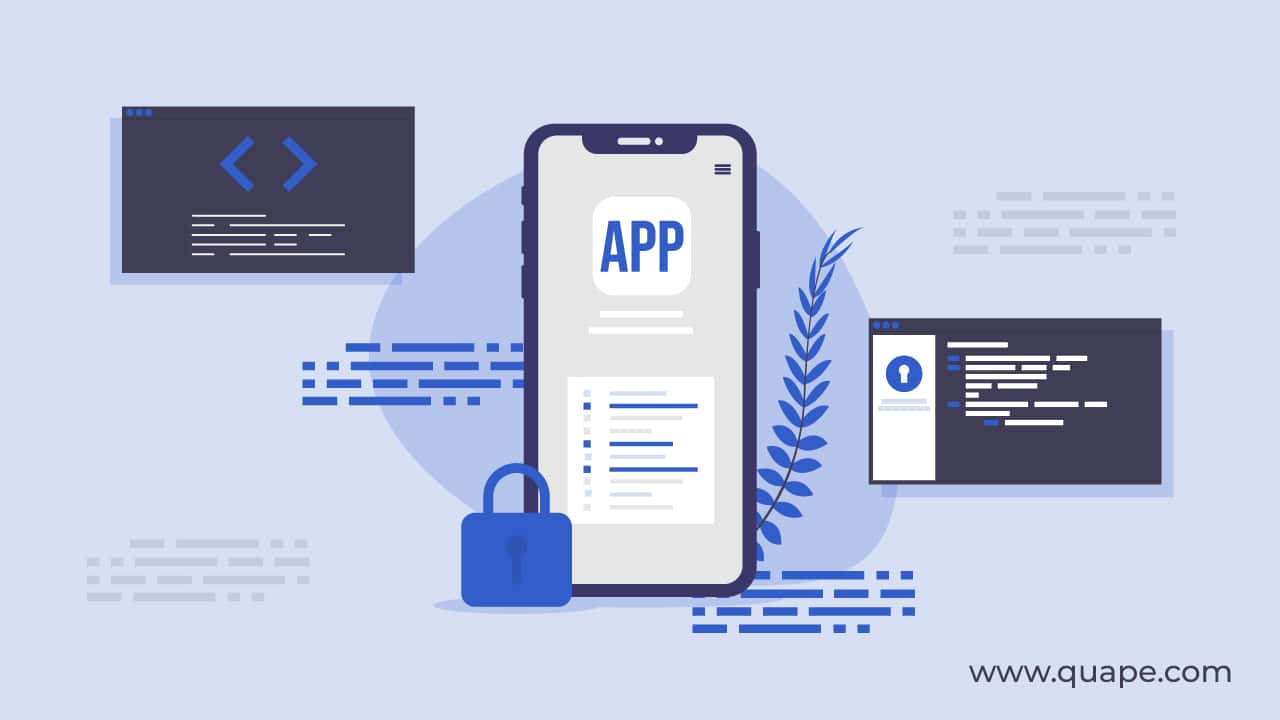
8 Tips to Make Your Mobile App More Secured
Mobile devices allow us to do almost everything online— anywhere, any time. We can do our banking, track our fitness, control Internet of Things devices in our homes (such as coffee machine, air conditioner, …), go shopping, and even work remotely. Driving this mobile productivity is a multitude of mobile apps—software that connects via APIs and servers around the world to deliver data, services, and, ultimately, value and convenience to users.
Be that as it may, this all needs to occur under a shroud of very much designed security or organizations hazard risking their applications, their framework, their clients’ data, and their notorieties. Since where advanced movement flourishes, programmers aren’t a long way behind.
Applications and cell phones are huge focuses on malignant action. Arxan Technology’s 2016 State of App Security detailed that 90% of applications overviewed had no less than 2/10 of OWASP’s significant security dangers. Arxan likewise revealed that around half of associations haven’t designated any spending toward portable application security—a quite huge inconsistency when you consider the dangers of not securing a versatile application.
Hackers with malicious intent can:
- Inject malware into apps and onto devices where it can access data, store keystrokes, and steal screen lock passcodes
- Tamper with or copy your app’s code and reverse-engineer a spoof app containing malware
- Intercept sensitive information traveling over the airwaves
- Steal customer data for identity theft or fraud purposes
- Get hold of intellectual property and private business assets
- Access your IP or compromise your company’s back-end network
- Mobile apps and the APIs that power them have the potential to make systems and data vulnerable if they aren’t properly secured.
- Customers expect apps to be secure, and it can be easy to take that trust for granted. For apps that deal in large amounts of data or have strict compliance requirements, like finance or healthcare, this is especially true.
What can you do to secure your mobile app?
In case you’re making an application or have an application in advertising, odds are you’ve ceased to consider how to secure your application, your information, and your client’s information.
A portable application has a decent piece of pipes to make it work: there’s simply the product code, the business rationale toward the back system and the customer side, databases, APIs piping information between the two, the gadget and its working framework, and the client. Each assumes a vital part in the texture of the application’s security. For organizations with versatile applications in a swarmed, aggressive market, having powerful security could be a major differentiator. Here’s a glance at a couple of tips for you to consider with portable application security, and which specialists can enable you to shield your versatile resources from each edge.
#1 SECURE YOUR APP’S CODE FROM THE GROUND UP
Like any product extend, portable programming security should be a need from the very beginning. Be that as it may, local applications are not quite the same as web applications, where information and programming exist safely on a server and the customer side (or, program) is only an interface. With local applications nonetheless, that code dwells on the gadget once it’s downloaded, making it more available to those with a vindictive plan.
Numerous vulnerabilities can exist in an application’s source code, yet that is not where organizations center their security spending. System and information security segments are essential parts of the general security picture, yet security needs to begin with the application itself. Vulnerabilities can be caused by designer blunder, inability to test the code, or your application may simply be focused on particularly by a programmer.
Tips:
- Protect app code with encryption. You want the code to be secret, and hard to read. Obfuscation and minification are common measures, but they’re not enough. Stick with modern, well-supported algorithms coupled with API encryption.
- Test code for vulnerabilities, or run source code scanning.
- Hardened, secure app code should be portable between devices and operating systems, and be easy to patch and update. You don’t want users stuck without an update after a breach, so engineer code to be as agile as possible.
- Keep in mind things like file size, runtime memory, performance, and data and battery usage when adding security to an app. You want it to be secure, but not at the cost of performance and user experience.
- It’s easy to rely on an app store’s approval as proof that your app is secure, but that would be a mistake. Apps have to be tested and approved, but app store approval processes aren’t 100% infallible, and some unsafe native apps have been approved in the past.
#2 SECURE YOUR NETWORK CONNECTIONS ON THE BACKEND
Servers and cloud servers that an application’s APIs are getting to (your own, or outsider) ought to have safety efforts set up to secure information and forestall unapproved get to. APIs and those getting to them ought to be confirmed to avoid listening in on delicate data going from the customer back to the application’s server and database.
Tips:
- Containerization is a method of creating encrypted containers for securely storing your data and documents.
- Consult a network security specialist to conduct penetration testing and vulnerability assessments of your network to ensure the right data is protected in the right ways.
- Database encryption and encrypted connections with a VPN (virtual private network), SSL (secure sockets layer), or TLS (transport layer security) add extra security.
- Federation is a next-level security measure that spreads resources out across servers so they’re not all in one place, and separates key resources from users, often with encryption measures.
#3 PUT IDENTIFICATION, AUTHENTICATION, AND AUTHORIZATION MEASURES IN PLACE.
Similarly, as with APIs, confirmation and approval innovation enables clients to demonstrate to an application their identity, adding another layer of security to the login procedure.
Tips:
- If your app relies on someone else’s API for functionality, use caution. You’re relying on their code to be secure. Make sure the APIs your app uses only provide access to the parts of your app that are absolutely necessary to minimize vulnerability.
- OAuth2 has become the gold-standard protocol for managing secure connections via user-specific, one-time tokens. Installing this framework on your authorization server and customizing it to your needs will allow you to grant user permissions between the client and end-users by collecting credentials, like 2-factor SMS questions.
- JSON web tokens for encrypted data exchange are lightweight and ideal for mobile security.
- OpenID Connect is a federation protocol specifically designed for mobile. It allows users to reuse their same credentials across multiple domains with an ID token, so they don’t have to register and sign in at each point.
#4 BE MINDFUL OF HOW CUSTOMER DATA IS SECURED AND IMPLEMENT A GOOD MOBILE ENCRYPTION POLICY.
As said above, all the more a portable application’s code and information must be put away on a gadget than with a conventional web application since you’re representing the shifting execution, data transfer capacity, and nature of gadgets. The more information that is put away locally on a gadget (regardless of whether that is for all time, or just briefly), the more helpless it is.
“Cracked” applications can discharge client information without clients knowing it—portable information focuses that are entered or gathered out of sight like age, area, gadget use propensities.
Tips:
- File-level encryption protects data on a file-by-file basis and is a way to encrypt at-rest data so it cannot be read if intercepted.
- Encrypt mobile databases. For example, the Appcelerator platform offers an encrypted SQLite module so data stored locally is safe.
- Design apps so that very sensitive customer data like passwords, credit card information, etc. aren’t stored directly on a device. If they are stored there, make sure it’s secure, encrypted storage. For example, iOS has encrypted data storage in its keychain. Note what data and analytics are being collected, how, and when, and where that data moves.
- Make key management a priority—even a strong algorithm can be negated if keys and certificates are vulnerable to hackers. If a key is shipped within an app’s byte code, for example, that makes any encryption moot.
#5 HAVE A SOLID API SECURITY STRATEGY IN PLACE
Since versatile improvement pivots so solidly on APIs, a vast part of securing portable applications is securing their APIs. APIs stream information between applications, the cloud, and a large number of various clients, every one of whom should be checked and approved to get to that information. APIs are the primary conductors for substance, usefulness, and information, so guaranteeing legitimate API security is an essential piece of the chain.
Tip:
- Three main security measures compriseThere are three main security measures that comprise a well-built API security stack: identification, authentication, and authorization.
Read more in this article, Tips for Building a Safe and Secure API.
#6 TEST YOUR APP SOFTWARE—THEN TEST AGAIN
Testing application code is normally pivotal in an application’s improvement procedure. Applications are being delivered so quickly, what ought to be an imperative stride in the process regularly tumbles to the wayside to accelerate time to advertise.
When testing for usefulness and ease of use, specialists encourage to likewise test for security, regardless of whether your application is a local, half breed, or web application. You’ll have the capacity to distinguish vulnerabilities in the code so you can revise them before distributing your application out.
Tips:
- Penetration testing entails deliberately probing a network or system for weaknesses.
- Test thoroughly for authentication and authorization, data security issues, and session management.
- Emulators for devices, operating systems, and browsers let you test how an app will perform in a simulated environment.
#7 USERS: PROTECT YOUR DEVICES
App makers can’t do a lot to ensure users have secure devices when they’re downloading apps, but here are a few pointers for users who want to avoid security issues, or identity theft or fraud if a device is lost or stolen.
Tips:
- Don’t use a jailbroken or rooted device. This removes the built-in security measures the device comes with and you’re left more vulnerable as a result.
- Only download apps from trusted sources, like authorized app stores.
#8 IF YOU’RE AN ENTERPRISE ORGANIZATION WITH A BYOD (BEING YOUR OWN DEVICE) POLICY, USE EXTRA CAUTION.
For organizations that enable workers to utilize their own particular gadgets, this can likewise open up the system to hacking vulnerabilities and make it harder for the IT division to control access to information on their backend frameworks. Cell phone administration (MDM) items are regularly commendable speculation, as Airwatch and MobileIron. These can give representatives the comfort of taking a shot at the go, yet additionally, give organizations genuine feelings of serenity with regards to security.
Tips:
- Implement a VPN to create a secure connection that’s less likely to be vulnerable to hackers listening in over an unsecured network.
Block unauthorized devices, and secure cleared devices with firewall, antivirus, and anti-spam software - Make devices “risk-aware” so that apps attempting to make certain transactions are blocked from doing so. Apps can be coded to detect and block certain transactions from rooted devices.
- Or, enable “remote wipe” capabilities to remove sensitive data from a device that’s been lost or stolen, or belongs to someone no longer with the company.
- Mobile is increasingly where users are, and increasingly where hackers are lurking to try and steal sensitive information and compromise app security. With a solid mobile security strategy and a top-notch mobile developer on hand to help you respond quickly to threats and bugs, your app will be a safer, more secure place for users—and ensure their loyalty (and your assets) for the future.
Quape has a team of experienced engineers ready to help you build a secured mobile app. Let’s talk to us if you are interested.






